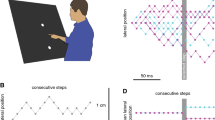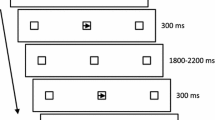Summary
We have evaluated the use of visual information about the movement of a target in two tasks tracking and interceptions — involving multi-joint reaching movements with the arm. Target velocity was either varied in a pseudorandom order (random condition) or was kept constant (predictable condition) across trials. Response latency decreased as target velocity increased in each condition. A simple model that assumes that latency is the sum of two components — the time taken for target motion to be detected, and a fixed processing time — provides a good fit to the data. Results from a step-ramp experiment, in which the target stepped a small distance immediately preceding the onset of the ramp motion, were consistent with this model. The characteristics of the first 100 ms of the response depended on the amount of information about target motion available to the subject. In the tracking task with randomly varied target velocities, the initial changes in hand velocity were largely independent of target velocity. In contrast, when the velocity was predictable the initial hand velocity depended on target velocity. Analogously, the initial changes in the direction of hand motion in the interception task were independent of target velocity in the random condition, but depended on target velocity in the predictable condition. The time course for development of response dependence was estimated by controlling the amount of visual information about target velocity available to the subject before the onset of limb movement. The results suggest that when target velocity was random, hand movement started before visual motion processing was complete. The response was subsequently adjusted after target velocity was computed. Subjects displayed idiosyncratic strategies during the catch-up phase in the tracking task. The peak hand velocity depended on target velocity and was similar for all subjects. The time at which the peak occurred, in contrast, varied substantially among subjects. In the interception task the hand paths were straighter in the predictable than in the random condition. This appeared to be the result of making adjustments in movement direction in the former condition to correct for initially inappropriate responses.
Similar content being viewed by others
References
Atkeson CG, Hollerbach JM (1985) Kinematic features of unrestrained vertical arm movements. J Neurosci 5:2318–2330
Biguer B, Jeannerod M, Prablanc C (1982) The coordination of eye, head, and arm movements during reaching at a single visual target. Exp Brain Res 46:301–304
Biguer B, Jeannerod M, Prablanc C (1985) The role of position of gaze in movement accuracy. In: Posner MI and Marin OSM (eds) Mechanisms of attention (Attention and performance, vol XI). Erlbaum, Hillsdale, pp 407–424
Carl JR, Gellman RS (1987) Human smooth pursuit: stimulusdependent responses. J Neurophysiol 57:1446–1463
Collewijn H (1972) Latency and gain of the rabbit's optokinetic reactions to small movements. Brain Res 36:59–70
Cordo PJ, Flanders M (1989) Sensory control of target acquisition. Trends Neurosci 12:110–117
Donkelaar P van, Gellman RS, Lee RG (1991) The effects of predictability on the initiation of reaching to moving targets. Soc Neurosci Abstr 17:1386
Favilla M, Hening W, Ghez C (1989) Trajectory control in targeted force impulses. VI. Independent specification of response amplitude and direction. Exp Brain Res 75:280–294
Fisk JD, Goodale MA (1985) The organization of eye and limb movements during unrestricted reaching in contralateral and ipsilateral visual space. Exp Brain Res 60:159–178
Flanders M, Cordo PJ (1989) Kinesthetic and visual control of a bimanual task: specification of direction and amplitude. J Neurosci 9:447–453
Frens MA, Erkelens CJ (1991) Coordination of hand movements and saccades: evidence for a common and a separate pathway. Exp Brain Res 85:682–690
Gellman RS, Carl JR (1991) Motion processing for saccadic eye movements in humans. Exp Brain Res 84:660–667
Georgopoulos AP, Kalaska JF, Massey JT (1981) Spatial trajectories and reaction times of aimed movements: effects of practice, uncertainty, and change in target location. J Neurophysiol 46:725–743
Gielen CCAM, Heuval PJM van den, Gisbergen JAM van (1984) Coordination of fast eye and arm movements in a tracking rask. Exp Brain Res 56:154–161
Hening W, Favilla M, Ghez C (1988) Trajectory control in targeted force impulses. V. Gradual specification of response amplitude. Exp Brain Res 71:116–128
Herman R, Herman R, Maulucci R (1981) Visually triggered eyearm movements in man. Exp Brain Res 42:392–398
Lisberger SG, Westbrook LE (1985) Properties of visual inputs that initiate horizontal smooth pursuit eye movements in monkeys. J Neurosci 5:1662–1673
Rosenbaum DA (1980) Human movement initiation: specification of arm, distance, and extent. J Exp Psychol [Gen] 109:444–474
Soechting JF, Lacquaniti F (1981) Invariant characteristics of a pointing movement in man. J Neurosci 1:710–720
Stanford TR, Carney LH, Sparks DL (1990) The amplitude of visually guided saccades is specified gradually in humans. Soc Neurosci Abstr 16:901
Tynan PD, Sekuler R (1982) Motion processing in peripheral vision: reaction time and perceived velocity. Vision Res 22:61–68
Van Sonderen JF, Denier van der Gon JJ (1991) Reaction-timedependent differences in the initial movement direction of fast goal-directed arm movements. Hum Mov Sci 10:713–726
Author information
Authors and Affiliations
Rights and permissions
About this article
Cite this article
van Donkelaar, P., Lee, R.G. & Gellman, R.S. Control strategies in directing the hand to moving targets. Exp Brain Res 91, 151–161 (1992). https://doi.org/10.1007/BF00230023
Received:
Accepted:
Issue Date:
DOI: https://doi.org/10.1007/BF00230023




